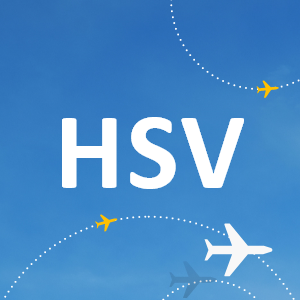
The Huntsville metropolitan area is located in North Alabama approximately 200 miles west of Atlanta and 120 miles south of Nashville. The region is served by Huntsville International Airport (HSV). This region is included as a case study because of its cargo and freight activities.

Regional Economic Strengths
| 2008 | 2019 | Change # | Change % | |
|---|---|---|---|---|
| Population (000s) | 554 | 624 | 70 | 13% |
| Total Employment (000s) | 344 | 388 | 45 | 13% |
The region has undergone significant growth in population and employment since 2008, outpacing the growth of Alabama as a whole. Both population and employment in the area have risen by 13 percent since 2008, while Alabama’s population has risen by 4 percent, and employment has risen by 6 percent.
The region is a center of aerospace-related activities. Huntsville is the home of the National Aeronautics and Space Administration’s (NASA’s) Marshall Space Flight Center, and the U.S. Army Aviation and Missile Command is headquartered at Redstone Arsenal. Large private companies in the area include Boeing, Dynetics, and Northrup Grumman. The U.S. Cluster Mapping Project notes that the area’s economy features multiple tradeable clusters that are among the top performers in the country, including information technology and analytical instruments; communications equipment and services; and marketing, design, and publishing.
Considering the NASA and military facilities in the region, it is not surprising that the public sector has a large share of total employment. In the private sector, the largest industry sector was professional, scientific, and technical services (PST) followed by manufacturing. Since 2015, PST employment has grown by almost 8,700 (21 percent), and employment in manufacturing has grown by 4,000 (10 percent).
The Airport and Its Services

HSV is a small-hub airport that handled a record 725,000 enplaned passengers in 2019. More importantly for this case study, HSV’s air cargo tonnage in 2019 totaled 88,769 metric tons, of which 81,740 metric tons (92 percent) were carried on international flights. The airport authority also operates the International Intermodal Center (air cargo and rail cargo) with Norfolk Southern and a Foreign Trade Zone. HSV enjoys robust international air cargo service thanks to the operations of DSV Panalpina (DSV), a Danish transport and logistics company offering transport services globally. Since then, the DSV forwarder-controlled freighter network at HSV has grown to include Brazil, Hong Kong, and Mexico using leased and chartered freighters. HSV’s cargo facilities have grown with the freighter operation—extending runways, expanding taxiways, and building cargo facilities that now total more than 300,000 square feet, including multiple temperature-controlled facilities.
More than 30 years after its inception, the DSV forwarder-controlled freighter network continues to operate high levels of cargo service while carrying a diverse array of commodities and adding new customers. The DSV network at HSV has become a model for other alternative cargo gateway airports to emulate even as it continues to evolve and innovate.
Air Cargo Linkages to Regional Economic Development
Interviews with HSV management revealed strong linkages between the airport’s cargo operations and regional economic development. Existing business retention and new business attraction can be traced back to the presence of convenient, reliable air cargo services.
HSV’s business development team has cultivated a cooperative environment within the region where the macro-benefits of economic development outweigh territorial self-interests, producing results for the broader economic region.
Two examples of linkages between HSV’s air cargo services and the economic development of the automotive industry in the region are the opening of a new Mercedes plant and a joint venture of Toyota and Mazda that resulted in the construction of a large manufacturing plant. Both are supported by HSV air cargo.
Regional Stakeholder Support of the Airport and Its Contributions to Economic Development
The Huntsville Chamber of Commerce recognizes the value of HSV’s nonstop international cargo flights to Luxembourg, Hong Kong, Mexico City, and Sao Palo. The Chamber’s annual report highlights the number of jobs created and capital investments, including those tied to foreign-based companies with locations in the region. The Huntsville Metropolitan Planning Organization notes the economic contribution of the airport by referencing the connections with international markets:
The presence of many international companies has been a driving force in continuous economic growth in North Alabama. The Jetplex Industrial Park is home to LG Electronics, the first Korean manufacturing operation located in North America. In Madison County alone, there are over 60 foreign-based corporations. These include representation from Canada, France, Denmark, Germany, Ireland, Italy, Japan, Korea, Kuwait, Netherlands, Singapore, South Africa, Sweden, Switzerland, and the UK.
TRIP 2045, City of Huntsville Area Planning Division and the Huntsville Area Metropolitan Planning Organization, May 2020, pp. 96–98.
